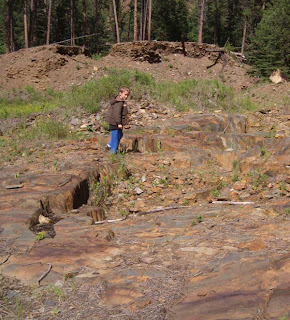First of all we’ll give you an update on our small scale
mining permit. The US Forest Service
signed off on the Plan of Operations for the Iron Creek permit. We meet with a ranger this week to walk
through the site which archaeology has marked out for our disturbance area.
Everything at the state level (Department of Environment and
Natural Resources) is in the works, bond awaiting approval before permit
issued.
We also attended the GPAA Gold and Treasure Show, running
into a couple of our prospecting friends there. Alex wanted everything, but we
kept our purchases to things we have trouble finding locally. We did see a
really nice little 5-gallon bucket buggy that I’m still contemplating… but it
can be found here at a local ag-related store that we patronize.
Now we’ll get back to the “fuss” regarding our small scale
permit versus any other small scale permit!
We have discussed that our mine site falls within the
Spearfish Creek watershed. This fact
automatically put us in a position for a hearing before the Board of Minerals.
There was also an “intervener” due to this designation, worded that he did not
request denial of permit but wanted to make sure the watershed was properly
protected.
So we are first-timers in the permit process, and although we
understood the implications of this ruling as setting precedence, we did not
know the technicalities required by the hearing for approval.
The first surprise to us when on-site with the Board of
Minerals was that placer mining is an unknown other than that people like to
pan gold. Several members had questions
as to how we go about it, what equipment is used, etc.
So the discussion quickly shifted from emphasis on our
project to placer mining in general. It
sure made it all a lot more fun for us, talking about what we love to do!
The intervener made an attempt to discredit the project with
a sweeping gesture from rim to rim of the meadow, telling all that massive
flooding had created that drainage and massive flooding can occur at any
time. We’ll get back to this shortly…
So that was the on-site.
Now we get to the hearing itself, which is available on audio
at SD DENR website.
The Attorney General staff outlined what needed to be
addressed in the hearing. This gets a
little complex…
The Board of Minerals in previous years negotiated and
approved the Spearfish Creek watershed to a preliminary list of unique and
scenic properties in South Dakota. This
was based, as far as we can tell, on the fact that Spearfish Creek is able to
sustain a trout population.
The Board, because of our permit, was assigned to determine
our four-acre mine site as either removed from the list (or) finally designated
as scenic and unique. This ruling, it
was made clear, applied only to that four acres and there were only two option
available.
There was quite a lot of discussion of pre-existing donut
holes, something we weren’t aware of.
These occur in the area called the Deadwood Standard project. Those areas were already permitted at the
time of designation to this preliminary list, therefore were left out of the
watershed.
DENR was next on the agenda, with a gratifyingly complete
report on not only our project but geology of the area, hydrology, and a very
thorough explanation of placer mining and equipment that we would use in the
project.
So we get to my testimony, which was made blessedly short by
the thorough DENR presentation. It was my opportunity to address the intervener’s
broad statement regarding historic flooding.
I agreed with how th3 meadow was created historically by flooding, but
pointed out that Iron Creek Lake exists just a few thousand feet up the
gulch. Little spring run-off occurs in
our mine area. In fact, our creek flow
is primarily dependent on discharge from Iron Creek Lake. So historic flooding as portrayed, will fill
and flood Iron Creek Lake, not our mine site.
Time for testimony of the intervener, James Nelson. I recall last week’s Rapid City Journal story
about the Lawrence County Commission and the Deadwood Standard project… ½ hour
of scenic shots of Spearfish Canyon.
That’s about what we saw and heard also.
It came time for us to ask questions and Bob addressed the impact of 200
homes and septic systems in Spearfish Canyon versus a four-acre mine a couple
of miles up Iron Creek.
It was then the Board of Minerals chance to ask questions and
it got a little pointed in that scenic and unique does not define in any way
the “McMansions” and septic systems allowed in Spearfish Canyon. These homes
are permanent footprints on the Canyon. We were gratified to see this same
comment reflected a few days later regarding the Deadwood Standard project.
So the result of all this is the permit was approved, the
four acres designated as scenic and unique but conditions put in place to allow
mining.
We conclude this with little else to say except that I will
attempt to explain in a future blog some of the Deadwood Standard project
questions we are getting as to the why and wherefore of events happening. We’re not involved in that project, but do
have a better understanding of the whole
permitting process!
Support your local miners… we contribute to the local economy
and reclaim as we go!











